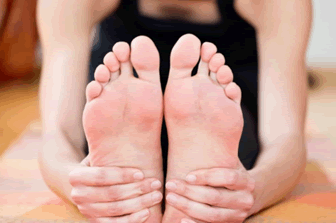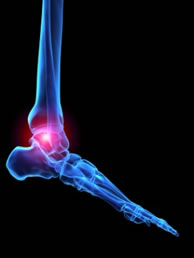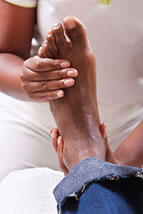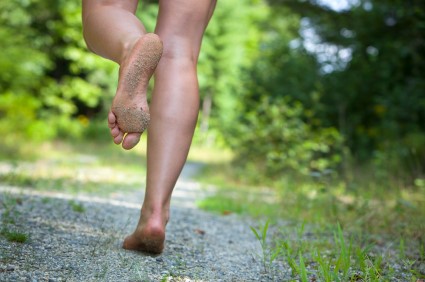Connect With Us
Items filtered by date: April 2016
What is Plantar Fasciitis?
 Plantar fasciitis is characterized as inflammation of the heel, flaring up without warning and developing over time. The condition requires time to heal and can be treated with surgery. Plantar fasciitis can be caused by many different issues, which can range from recent injury, sudden weight gain, too much strenuous exercise, and ill-fitting footwear. Changing up your footwear and opting for solutions such as cortico-steroid injections, night splints, custom orthotics, or physical therapy can help treat plantar fasciitis.
Plantar fasciitis is characterized as inflammation of the heel, flaring up without warning and developing over time. The condition requires time to heal and can be treated with surgery. Plantar fasciitis can be caused by many different issues, which can range from recent injury, sudden weight gain, too much strenuous exercise, and ill-fitting footwear. Changing up your footwear and opting for solutions such as cortico-steroid injections, night splints, custom orthotics, or physical therapy can help treat plantar fasciitis.
Plantar fasciitis can be very painful and inconvenient. If you are experiencing heel pain or symptoms of plantar fasciitis, contact one of our podiatrists of The Podiatry Center, P.C.. Our doctors will treat your foot and ankle needs.
What is Plantar Fasciitis?
Plantar fasciitis is the inflammation of the thick band of tissue that runs along the bottom of your foot, known as the plantar fascia, and causes mild to severe heel pain.
What Causes Plantar Fasciitis?
· Excessive running
· Non-supportive shoes
· Overpronation
· Repeated stretching and tearing of the plantar fascia
How Can It Be Treated?
· Conservative measures – anti-inflammatories, ice packs, stretching exercises, physical therapy, orthotic devices
· Shockwave therapy – sound waves are sent to the affected area to facilitate healing and are usually used for chronic cases of plantar fasciitis
· Surgery – usually only used as a last resort when all else fails. The plantar fascia can be surgically detached from the heel
While very treatable, plantar fasciitis is definitely not something that should be ignored. Especially in severe cases, speaking to your doctor right away is highly recommended to avoid complications and severe heel pain. Your podiatrist can work with you to provide the appropriate treatment options tailored to your condition.
If you have any questions, please feel free to contact our office located in Millburn, NJ. We offer the newest diagnostic tools and technologies to treat your foot and ankle needs.
Rheumatoid Arthritis Affects Women More Commonly than Men
 According to belmarrahealth.com, rheumatoid arthritis in women may be more fatal than women who do not have the disease. Rheumatoid arthritis, classified as a chronic condition, displays symptoms of inflammation, pain, stiffness, and disability in the joints. The disease affects women more commonly than men. If you notice any symptoms, such as random fatigue, irritation in the joints, fever, weight loss, eye irritation, foot pain, or sudden growths beneath the skin, contact your doctor immediately. Treating your symptoms when they begin appearing is essential in preventing the progression of the disease.
According to belmarrahealth.com, rheumatoid arthritis in women may be more fatal than women who do not have the disease. Rheumatoid arthritis, classified as a chronic condition, displays symptoms of inflammation, pain, stiffness, and disability in the joints. The disease affects women more commonly than men. If you notice any symptoms, such as random fatigue, irritation in the joints, fever, weight loss, eye irritation, foot pain, or sudden growths beneath the skin, contact your doctor immediately. Treating your symptoms when they begin appearing is essential in preventing the progression of the disease.
Because RA affects more than just your joints, including the joints in your feet and ankles, it is important to seek early diagnosis from your podiatrist if you feel like the pain in your feet might be caused by RA. For more information, contact one of our podiatrists of The Podiatry Center, P.C.. Our doctors will treat your foot and ankle needs.
What Is Rheumatoid Arthritis?
Rheumatoid Arthritis (RA) is an autoimmune disorder in which the body’s own immune system attacks the membranes surrounding the joints. Inflammation of the lining and eventually the destruction of the joint’s cartilage and bone occur, causing severe pain and immobility.
Rheumatoid Arthritis of the Feet
Although RA usually attacks multiple bones and joints throughout the entire body, almost 90 percent of cases result in pain in the foot or ankle area.
Symptoms
- Swelling & pain in the feet
- Stiffness in the feet
- Pain on the ball or sole of feet
- Joint shift and deformation
Diagnosis
Quick diagnosis of RA in the feet is important so that the podiatrist can treat the area effectively. Your doctor will ask you about your medical history, occupation, and lifestyle to determine the origin of the condition. Rheumatoid Factor tests help to determine if someone is affected by the disease.
If you have any questions, please feel free to contact our office located in Millburn, NJ. We offer the newest diagnostic tools and technologies to treat your foot and ankle needs.
When Hammertoes Become Serious
 Hammertoes may indicate more than meets the eye, suggests PR Newswire. Although a hammertoe may start off as a physical deformity, they may be part of a larger problem. The condition may be caused by an acute injury to the plantar plate ligament, which can become serious if left undiagnosed and untreated. The recommended option is surgery for correcting the toes and plate. See your podiatrist or a foot and ankle surgeon to pursue the proper course of action when addressing an extreme hammertoe condition.
Hammertoes may indicate more than meets the eye, suggests PR Newswire. Although a hammertoe may start off as a physical deformity, they may be part of a larger problem. The condition may be caused by an acute injury to the plantar plate ligament, which can become serious if left undiagnosed and untreated. The recommended option is surgery for correcting the toes and plate. See your podiatrist or a foot and ankle surgeon to pursue the proper course of action when addressing an extreme hammertoe condition.
Hammertoes can be a painful condition to live with. For more information,contact one of our podiatrists of The Podiatry Center, P.C.. Our doctors will treat your foot and ankle needs.
Hammertoe
Hammertoe is a foot deformity that affects the joints of the second, third, fourth, or fifth toes of your feet. It is a painful foot condition in which these toes curl and arch up, which can often lead to pain when wearing footwear.
Symptoms
- Pain in the affected toes
- Development of corns or calluses due to friction
- Inflammation
- Redness
- Contracture of the toes
Causes
- Genetics – people who are genetically predisposed to hammertoe are often more susceptible
- Arthritis – because arthritis affects the joints in your toes, further deformities stemming from arthritis can occur
- Trauma – direct trauma to the toes could potentially lead to hammertoe
- Ill-fitting shoes – undue pressure on the front of the toes from ill-fitting shoes can potentially lead to the development of hammertoe
Treatment
- Orthotics – custom made inserts can be used to help relieve pressure placed on the toes and therefore relieve some of the pain associated with it
- Medications – oral medications such as anti-inflammatories or NSAIDs could be used to treat the pain and inflammation hammertoes causes. Injections of corticosteroids are also sometimes used
- Surgery – in more severe cases where the hammertoes have become more rigid, foot surgery is a potential option
If you have any questions, please feel free to contact our office located in Millburn, NJ. We offer the newest diagnostic tools and technologies to treat your foot and ankle needs.
Considering Minimalist Shoes for Barefoot Running
 Shoes that mimic goingbarefoot, otherwise known as minimalist shoes, are an alternative training option for those who like to run often. Minimalist shoes are lighter, less cushioned, have less height, and offer the simulation of running barefoot while still giving your feet protection. Minimalist shoes, however, may not be for everyone, and differ from person to person. See your doctor or podiatrist first to assess the condition and gait of your feet before deciding if minimalist shoes are for you.
Shoes that mimic goingbarefoot, otherwise known as minimalist shoes, are an alternative training option for those who like to run often. Minimalist shoes are lighter, less cushioned, have less height, and offer the simulation of running barefoot while still giving your feet protection. Minimalist shoes, however, may not be for everyone, and differ from person to person. See your doctor or podiatrist first to assess the condition and gait of your feet before deciding if minimalist shoes are for you.
Barefoot running has its own share of benefits and disadvantages. If you have any concerns about your feet or ankles, contact one of our podiatrists of The Podiatry Center, P.C.. Our doctors will treat your foot and ankle needs.
Barefoot Running
The Impact of Barefoot Running
-Running without shoes changes the motion of your running, as most running is done by landing on the heel of the feet.
-Running barefoot requires a different way of running; the landing is done on the front part of the feet.
The Advantages of Barefoot Running
-When running and landing on the front feet, the impact on the feet and ankle is reduced, this can reduce stress injuries.
-It strengthens muscles in the feet and ankles and the lower legs.
-Balance of the body is improved and there is a greater sensory input from the feet to the rest of the body.
The Drawbacks of Barefoot Running
-No protection while running, makes it likely that runners will land on sharp objects and scrapes, bruises and cuts on the feet will result.
-Blisters may form.
-Possibility of plantar fascia problems.
-Risk of getting Achilles tendonitis.
So what can runners do to make barefoot running safe? It’s best to make a slow transition from running shoes to barefoot running. Once the feet begin to adjust, try walking, then jogging and gradually increasing the distance. Minimalist running shoes may also be an option.
If you have any questions, please feel free to contact our office located in Millburn, NJ. We offer the newest diagnostic tools and technologies to treat your foot and ankle needs.
Blog Archives
- April 2025
- March 2025
- February 2025
- January 2025
- December 2024
- November 2024
- October 2024
- September 2024
- August 2024
- July 2024
- June 2024
- May 2024
- April 2024
- March 2024
- February 2024
- January 2024
- December 2023
- November 2023
- October 2023
- September 2023
- August 2023
- July 2023
- June 2023
- May 2023
- April 2023
- March 2023
- February 2023
- January 2023
- December 2022
- November 2022
- October 2022
- September 2022
- August 2022
- July 2022
- June 2022
- May 2022
- April 2022
- March 2022
- February 2022
- January 2022
- December 2021
- November 2021
- October 2021
- September 2021
- August 2021
- July 2021
- June 2021
- May 2021
- April 2021
- March 2021
- February 2021
- January 2021
- December 2020
- November 2020
- October 2020
- September 2020
- August 2020
- July 2020
- June 2020
- May 2020
- April 2020
- March 2020
- February 2020
- January 2020
- December 2019
- November 2019
- October 2019
- September 2019
- August 2019
- July 2019
- June 2019
- May 2019
- April 2019
- March 2019
- February 2019
- January 2019
- December 2018
- November 2018
- October 2018
- September 2018
- August 2018
- July 2018
- June 2018
- May 2018
- April 2018
- March 2018
- February 2018
- January 2018
- December 2017
- November 2017
- October 2017
- September 2017
- August 2017
- July 2017
- June 2017
- May 2017
- April 2017
- March 2017
- February 2017
- January 2017
- December 2016
- November 2016
- October 2016
- September 2016
- August 2016
- July 2016
- June 2016
- May 2016
- April 2016
- March 2016
- February 2016
- January 2016
- December 2015
- November 2015
- October 2015
- September 2015
- August 2015
- July 2015
- June 2015
- May 2015
- January 2014
- December 2013
- November 2013
- October 2013
- September 2013
- August 2013
- July 2013
- June 2013
- May 2013
- April 2013
- March 2013
- February 2013
- January 2013
- December 2012
- November 2012
- October 2012
- September 2012
- August 2012
- July 2012
- June 2012
